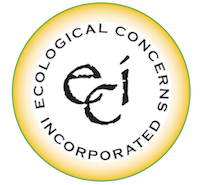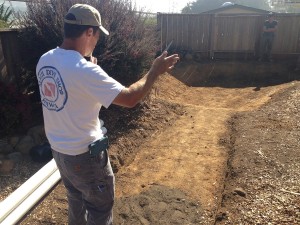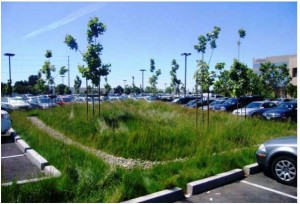Rain Gardens and Bioretention Areas – A Quick Guide to Post Construction Water Quality Treatment
Rain gardens and bioretention areas are permanent landscape features that are designed and constructed using Low Impact Development (LID) principals. Professionals and residents around the Bay Area are installing these systems to reduce stormwater pollutants and to protect our limited natural resources. Both act as water quality improvement measures by capturing and filtering stormwater before it enters creeks, rivers and streams.
The ultimate goals are to minimize sedimentation while removing pollutants from stormwater, allow for groundwater infiltration and minimize the landscapes irrigation needs. The difference between rain gardens and bioretention areas is size. Bioretention areas are larger and are used in commercial or agricultural settings for satisfying municipal permitting requirements. Rain gardens are generally smaller and emphasize collection and filtration of residential stormwater; permits are usually not required. Another helpful resource is the C-3 Handbook published by the Santa Clara Valley Urban Runoff Pollution Prevention Program.
Both of these post construction measures can involve the application of biotreatment soil. It depends on the infiltration objectives and the infiltration rate of the native soil. For smaller residential rain gardens, you could also use a good compost. A standard biotreatment soil is composed of approximately 65% sand and 35% compost. A biotreatment soils main purpose is to allow for faster infiltration rates and provide interface with the plants roots and remove pollutants. Biotreatment soil is installed at the end of the construction process in order to protect it from potentially damaging construction-related impacts, including runoff of silt, debris, or other organic matter.
Because they adapt well to fluctuating wet and dry soil conditions, drought tolerant and/or California native plants are then planted in the biotreatment soil layer. Particularly good grasses and perennials include those listed below.
• Meadow Barley (Hordeum brachyantherum)
• Creeping Wildrye (Leymus triticoides)
• Common Rush (Juncus patens)
• California Aster (Aster chilensis)
• Golden Eyed Grass (Sisyrinchium californicum)
• Creeping Spikerush (Eleocharis macrostachya)
• Western Goldenrod (Euthamia occidentalis)
• Rosilla or Sneezeweed (Helenium puberulum)
• California Tiger Lily (Lilium pardalinum)
• Scarlet Monkeyflower (Mimulus cardinalis)
Local native plant nurseries are the best resource for recommending the most suitable plants for your location. In order to ensure that the bioretention and rain gardens function properly, they should be inspected and maintained regularly to ensure that there is no excessive sediment buildup, and that there is a dense vegetative cover.
Bill Halleck has over 30 years of experience in landscape architecture, land conservation and habitat restoration. Ecological Concerns Incorporated is a landscape contractor and Central Coast Wilds is its native plant nursery. Both are located in Santa Cruz, CA. Contact Bill with questions or comments at bhalleck@ecologicalconcerns.com.



